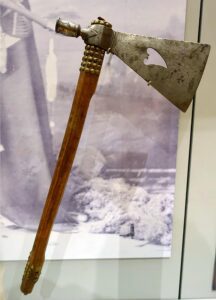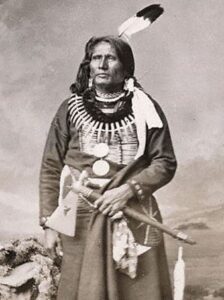Harvard returning Standing Bear’s tomahawk to Nebraska tribe

This undated photo shows a tomahawk once owned by Chief Standing Bear, a pioneering Native American civil rights leader, which will be returning to his Nebraska tribe after decades in a museum at Harvard University in Cambridge, Mass. The university’s Peabody Museum of Archaeology & Ethnology says it’s been working with members of the Ponca Tribe in Nebraska and Oklahoma to repatriate the artifact. (Harvard Crimson via AP)
July 6, 2021
BOSTON (AP) — A tomahawk once owned by Chief Standing Bear, a pioneering Native American civil rights leader, is returning to his Nebraska tribe after decades in a museum at Harvard.
The university’s Peabody Museum of Archaeology & Ethnology says it’s been working with members of the Ponca Tribe in Nebraska and Oklahoma to repatriate the artifact.
Larry Wright, Jr., chairman of the Ponca Tribe of Nebraska, said Tuesday the return of the historic weapon is a powerful symbol of homecoming for the tribe, which was among many forcibly relocated from their homelands to other territories by the federal government in the 1800s.
“That’s a piece of our history that represents who we are and why we’re here in Nebraska, so for it to be back home is very appropriate,” he said. “It tells that history and lets us never forgot what our people went through.”
Standing Bear was arrested 1878 for leaving the tribe’s Oklahoma reservation in order to fulfill a promise he made to bury his eldest son back in their tribe’s homeland in Nebraska’s Niobrara River Valley. In his landmark federal trial, he successfully argued for the recognition of Native Americans as persons entitled to rights and protection under law.
“That hand is not the color of yours. But if you pierce it, I shall feel pain,” Standing Bear famously said in court. “The blood that will flow from mine will be the same color as yours. I am a man. The same God made us both.”
There’s no firm timeline for the tomahawk’s homecoming, but Wright and other Ponca tribe leaders are slated to travel to Harvard in September, according to Jane Pickering, the museum’s director.
The tribe delegation will view the tomahawk as well as other items related to Standing Bear, including a beaded necklace, quilled moccasins and a pipe bowl, she said.
In the meantime, Wright said the Nebraska tribe is preparing its own museum, which is located near Standing Bear’s grave, to properly display the artifacts.
He also credited Brett Chapman, an Oklahoma lawyer and descendant of Standing Bear, for his efforts to raise awareness about the tomahawk and the importance of returning it.
“This heritage item belonged to the Ponca people then, it belongs to us now and after this, it will belong to us forever,” Chapman said Monday.
The tomahawk has changed hands several times over the decades.
Standing Bear, who died in 1908, originally bestowed the tomahawk to John Lee Webster, one of his lawyers in his landmark case, but the heirloom was sold to a private collector when Webster died, according to Chapman.
Harvard acquired it in 1982 when it was donated by the estate of William Henry Claflin Jr., a Belmont, Massachusetts, resident who had purchased it from the widow of William Morris, an Omaha attorney, in 1930, according to the museum. It’s unclear how Morris came into possession of the tomahawk.
Debate over the tomahawk comes as Harvard has faced criticism over its repatriation efforts.
The Association on American Indian Affairs said in February that the university does not always consult with tribes about cultural items that could be returned to them, in violation of federal law.
It also comes as Standing Bear is enjoying a revival of sorts.
A bronze statue of his likeness clutching his tomahawk was installed at the U.S. Capitol’s National Statuary Hall in 2019. Similar statues have also been recently raised in Lincoln, Nebraska’s capital, as well as the Ponca Tribe’s headquarters in Niobrara.
The post Harvard returning Standing Bear’s tomahawk to Nebraska tribe first appeared on Native Sun News Today.

